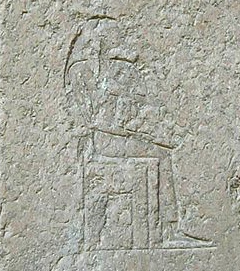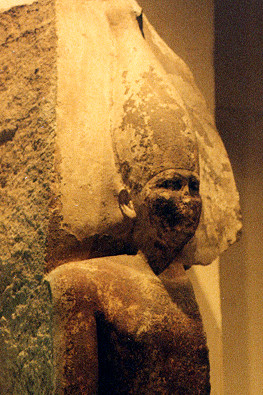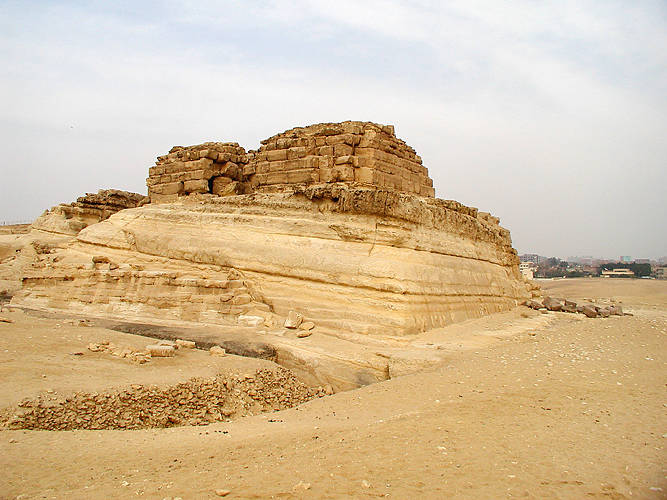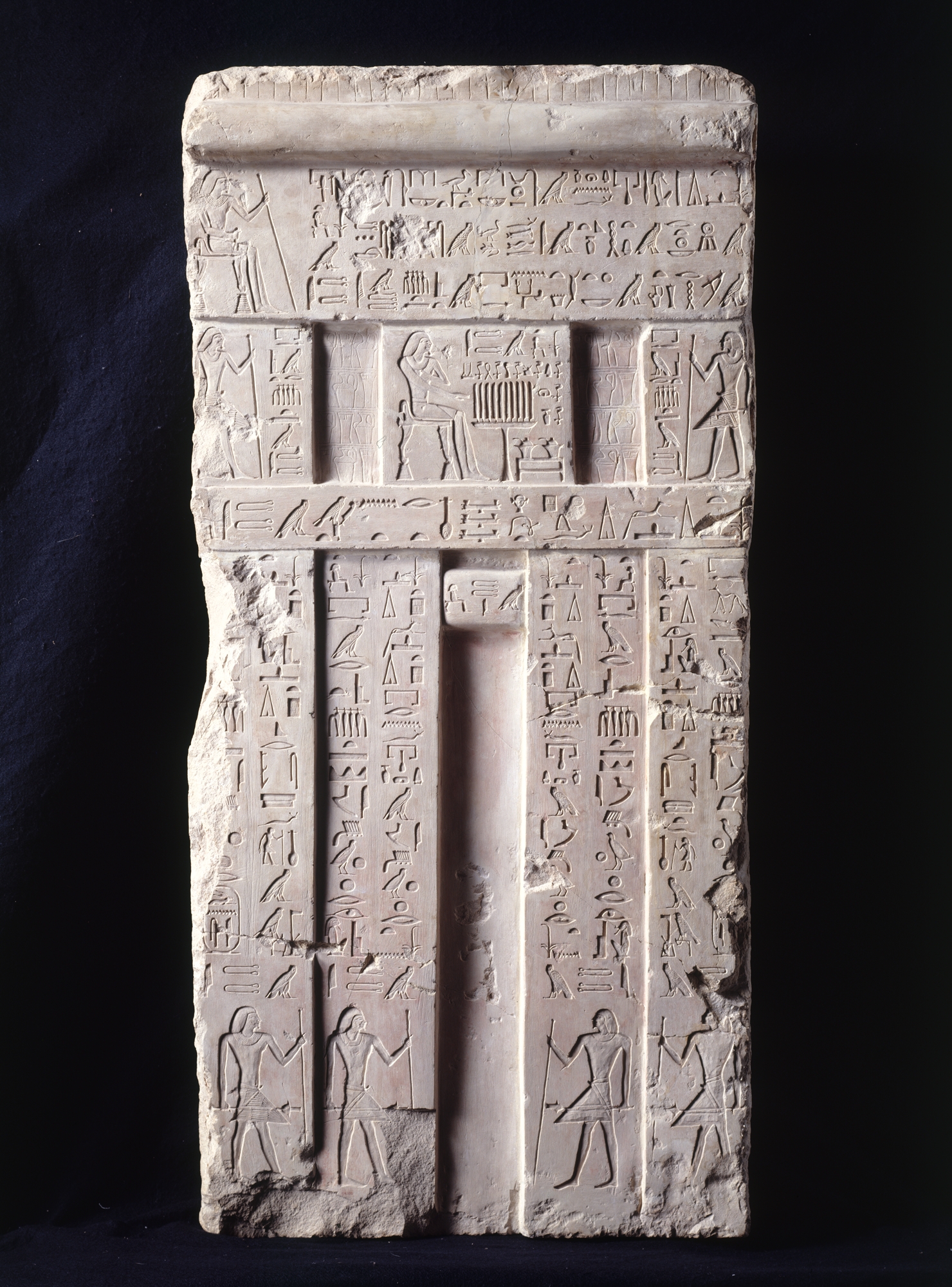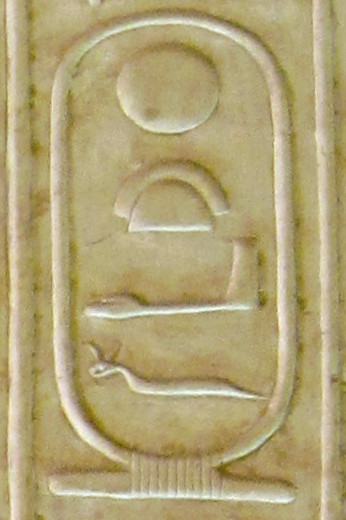|
Menkaure
Menkaure or Menkaura (; 2550 BC - 2503 BC) was a king of the Fourth Dynasty of Egypt during the Old Kingdom. He is well known under his Hellenized names Mykerinos ( by Herodotus), in turn Latinized as Mycerinus, and Menkheres ( by Manetho). According to Manetho, he was the throne successor of king Bikheris, but according to archaeological evidence, he was almost certainly the successor of Khafre. Africanus (from Syncellus) reports as rulers of the fourth dynasty Sôris, Suphis I, Suphis II, Mencherês (=Menkaure), Ratoisês, Bicheris, Sebercherês, and Thamphthis in this order. Menkaure became famous for his tomb, the Pyramid of Menkaure, at Giza and his statue triads, which showed him alongside the goddess Hathor and various regional deities. Family Menkaure was the son of Khafre and the grandson of Khufu. A flint knife found in the mortuary temple of Menkaure mentioned a king's mother Khamerernebty I, suggesting that Khafre and this queen were the parents of Me ... [...More Info...] [...Related Items...] OR: [Wikipedia] [Google] [Baidu] [Amazon] |
Shepseskaf
Shepseskaf (meaning "His Ka is noble") was a pharaoh of ancient Egypt, the sixth and probably last ruler of the fourth dynasty during the Old Kingdom period. He reigned most probably for four but possibly up to seven years in the late 26th to mid-25th century BC. Shepseskaf's relation to his predecessor Menkaure is not entirely certain; he might have been his son or possibly his brother. The identity of his mother is highly uncertain as she could have been one of Menkaure's consorts or queen Khentkaus I or Neferhetepes. Similarly, Shepseskaf's relation to his probable successor on the throne, Userkaf, is not known although in the absence of clear indication of strife at the transition between the fourth and fifth dynasties, Userkaf could well have been his son or his brother. If Shepseskaf was succeeded directly by Userkaf rather than by Thampthis as claimed by some historical sources, then his death marks the end of the fourth dynasty. The transition to the fifth dyna ... [...More Info...] [...Related Items...] OR: [Wikipedia] [Google] [Baidu] [Amazon] |
Pyramid Of Menkaure
The pyramid of Menkaure is the smallest of the three main pyramids of the Giza pyramid complex, located on the Giza Plateau in the southwestern outskirts of Cairo, Egypt. It is thought to have been built to serve as the tomb of the Menkaure , Fourth Dynasty King Menkaure. Size and construction Menkaure's pyramid had an original height of , and was the smallest of the three major pyramids at the Giza Necropolis. It now stands at tall with a base of . Its angle of incline is approximately 51°20′25″. It was constructed of limestone and Aswan granite. The upper portion was cased in the normal manner with Tura (Egypt), Tura limestone. The construction of the outer casing of the pyramid was halted at sixteen to eighteen layers of granite following Menkaure's death, only seven of which remain today due to vandalism and erosion. Part of the granite was left in the rough. The descending passage to lower burial chamber is in the 'large apartment' floor, probably original hidden by ... [...More Info...] [...Related Items...] OR: [Wikipedia] [Google] [Baidu] [Amazon] |
Fourth Dynasty Of Egypt
The Fourth Dynasty of ancient Egypt (notated Dynasty IV) is characterized as a "golden age" of the Old Kingdom of Egypt. Dynasty IV lasted from to c. 2498 BC. It was a time of peace and prosperity as well as one during which trade with other countries is officially documented. The Fourth Dynasty heralded the height of the pyramid-building age. The peaceful rule of the Third Dynasty of Egypt, Third Dynasty allowed artistic expressions to flourish. Building experiments done by King Sneferu led to the evolution of mastaba tombs into the smooth sided pyramids like those seen on the Giza Plateau. No other period in Egyptian history equaled the accomplishments achieved during the Fourth Dynasty.Egypt: Land and Lives of the Pharaohs Revealed, (2005), pp. 80–90, Global Book Publishing: Australia Rulers Summary of Listed Kings Sneferu Sneferu, lauded as "Bringer of Beauty", "Master of All Justice", and "Ruler of Lower and Upper Nile", was the first pharaoh of the fourt ... [...More Info...] [...Related Items...] OR: [Wikipedia] [Google] [Baidu] [Amazon] |
Khentkaus I
Khentkaus I, also referred to as Khentkawes () was a royal woman who lived in ancient Egypt Ancient Egypt () was a cradle of civilization concentrated along the lower reaches of the Nile River in Northeast Africa. It emerged from prehistoric Egypt around 3150BC (according to conventional Egyptian chronology), when Upper and Lower E ... during both the Fourth Dynasty and the Fifth Dynasty. She may have been a daughter of king Menkaure, the wife of both king Shepseskaf and king Userkaf (the founder of the Fifth Dynasty), the mother of king Sahure.Michael Rice: ''Who is who in Ancient Egypt'', Routledge London & New York 1999, , see p. 96 Some suggest that she was the regent for one of her sons. Perhaps, in her own right, she may have been the king of Upper and Lower Egypt, which aspects of her burial suggest. Her mastaba at Giza – tomb LG100 – is located very close to Menkaure's pyramid complex. This close connection may point to a family relationship. Although ... [...More Info...] [...Related Items...] OR: [Wikipedia] [Google] [Baidu] [Amazon] |
Bikheris
Bikheris () is the Hellenized name of an ancient Egyptian king, who may have ruled during the 4th Dynasty ( Old Kingdom period). Next to nothing is known about this ruler and some Egyptologists even believe him to be fictitious.Jürgen von Beckerath: ''Chronologie des pharaonischen Ägypten. Die Zeitbestimmung der ägyptischen Geschichte von der Vorzeit bis 332 v. Chr.'' (= ''Münchner ägyptologische Studien'', vol. 46). von Zabern, Mainz 1997, , p. 158. Identity Possible name sources In attempts to reconstruct Ancient Egyptian king lists, Egyptologists and historians face several problems. As already mentioned, ''Bikheris'' is a Hellenized name variation. The name appears in the book '' Aegyptiaca'' written by Manetho around 300 BC. In a Latin copy of Manetho, written by Eratosthenes, a king named ''Biuris'' is placed at the date when Bikheris allegedly ruled. Scholars wonder if both names actually derive from one and the same Egyptian source.Alan B. Lloyd: ''Commenta ... [...More Info...] [...Related Items...] OR: [Wikipedia] [Google] [Baidu] [Amazon] |
Khamerernebty II
Khamerernebty II was an ancient Egyptian queen of the 4th Dynasty. She was a daughter of Pharaoh Khafre and Queen Khamerernebty I. She married her brother Menkaure and she was the mother of Prince Khuenre. Family Khamerernebty II is said to be the daughter of Khamerernebty I in her tomb. Khamerernebty I is thought to be the mother of Menkaure based on a partial inscription on a flint knife in the mortuary temple of Menkaure and hence a wife of King Khafre. This would imply that Khamerernebty II was the daughter of King Khafre and Khamerernebty I.Dodson, Aidan and Hilton, Dyan. ''The Complete Royal Families of Ancient Egypt''. Thames & Hudson. 2004. Khamerernebty II was the mother of the King's Son Khuenre, who is thought to be the son of Menkaure. This suggests that Khamerernebty II must have married her brother Menkaure. Burial Khamerernebty II is mentioned in texts and on a statue found in the Galarza tomb in Giza Giza (; sometimes spelled ''Gizah, Gizeh, Geez ... [...More Info...] [...Related Items...] OR: [Wikipedia] [Google] [Baidu] [Amazon] |
Khuenre
Khuenre (Khuenra) () was a Prince of ancient Egypt of the 4th Dynasty, named after the Sun god Ra. Biography He may have been a son of Pharaoh, King Menkaure and was a son of his sister, Queen Khamerernebty II.Page about Menkaure by Anneke Bart He was a grandson of Khafre and Khamerernebty I and great-grandson of Khufu, the king who built the Great Pyramid of Giza. He was a secretary and "sole companion of his father".''Giza archives'' - page for Khuenre He was the eldest son of his parents, but he was not Menkaure’s successor as he predeceased him. Thus, Menkaure was succeeded by Shepseskaf.Clayton, pp. 57-58 Khuenre is buried in Menkaure’s cemetery (MQ 1). He is depicted as a young boy standing in front of his seated mother on the south wall. [...More Info...] [...Related Items...] OR: [Wikipedia] [Google] [Baidu] [Amazon] |
Old Kingdom Of Egypt
In ancient Egyptian history, the Old Kingdom is the period spanning –2200 BC. It is also known as the "Age of the Pyramids" or the "Age of the Pyramid Builders", as it encompasses the reigns of the great pyramid-builders of the Fourth Dynasty of Egypt, Fourth Dynasty, such as King Sneferu, under whom the art of pyramid-building was perfected, and the kings Khufu, Khafre and Menkaure, who commissioned the construction of the Giza pyramid complex, pyramids at Giza. Ancient Egypt, Egypt attained its first sustained peak of civilization during the Old Kingdom, the first of three so-called "Kingdom" Egyptian chronology, periods (followed by the Middle Kingdom of Egypt, Middle Kingdom and New Kingdom of Egypt, New Kingdom), which mark the high points of civilization in the lower Nile Valley. The Periodization of Ancient Egypt, concept of an "Old Kingdom" as one of three "golden ages" was coined in 1845 by the German Egyptology, Egyptologist Christian Charles Josias von Bunsen, Baron ... [...More Info...] [...Related Items...] OR: [Wikipedia] [Google] [Baidu] [Amazon] |
Khafre
Khafre or Chephren (died 2532 BC) was an ancient Egyptian monarch who was the fourth king of the Fourth Dynasty, during the earlier half of the Old Kingdom period (c. 2700–2200 BC). He was son of the king Khufu, and succeeded his brother Djedefre to the throne. Khafre's enormous pyramid at Giza, the Pyramid of Khafre, is surpassed only by his father's (the Great Pyramid). The Great Sphinx of Giza was also built for him, according to some egyptologists, although this remains unconfirmed. Not much is known about Khafre aside from the reports of Herodotus, a Greek historian who wrote 2,000 years later. Family Khafre was a son of king Khufu and the brother and successor of Djedefre. Khafre is thought by some to be the son of Queen Meritites I due to an inscription where he is said to honor her memory. Kings-wife, his beloved, devoted to Horus, Mertitytes. King's-wife, his beloved, Mertitytes; beloved of the Favorite of the Two Goddesses; she who says anything whatsoeve ... [...More Info...] [...Related Items...] OR: [Wikipedia] [Google] [Baidu] [Amazon] |
Khamerernebty I
Khamerernebty I was an ancient Egyptian queen of the 4th dynasty. She was probably a wife of King Khafre and the mother of King Menkaure and Queen Khamerernebty II. It is possible that she was a daughter of Khufu, based on the fact that inscriptions identify her as a King's daughter. Life Khamerernebty I is identified with the king's mother whose partial name was found inscribed on a flint knife in the mortuary temple of Menkaure. She is thought to be the mother of Menkaure and was likely married to King Khafre. There are no inscriptions that explicitly mention her as a wife of Khafre however. The Galarza tomb in Giza was originally probably built for Khamerernebty I, but was finished for her daughter Khamerernebty II. The inscriptions in this tomb are an important source of information about Khamerernebty I.Baud, Michel. "La tombe de la reine-mère xa-mrr-Nbtj Ire." Bulletin de l'Institut Français d'Archéologie Orientale 95 (1995), pp. 11-12, 18, fig. 1. The lintel above ... [...More Info...] [...Related Items...] OR: [Wikipedia] [Google] [Baidu] [Amazon] |
Abydos King List
The Abydos King List, also known as the Abydos Table or the Abydos Tablet, is a list of the names of 76 kings of ancient Egypt, found on a wall of the Temple of Seti I at Abydos, Egypt. It consists of three rows of 38 cartouches (borders enclosing the name of a king) in each row. The upper two rows contain names of the kings, while the third row merely repeats Seti I's throne name and nomen. Besides providing the order of the Old Kingdom kings, it is the sole source to date of the names of many of the kings of the Seventh and Eighth Dynasties, so the list is valued greatly for that reason. This list omits the names of many earlier pharaohs. The bulk of these appear to have been left out because although they claimed royal titles and rule over all Egypt, their actual authority was limited to only part of the country. This category includes all the rulers of the Ninth and Tenth Dynasties, the early rulers of the Eleventh Dynasty ( Mentuhotep I, Intef I, Intef II, and In ... [...More Info...] [...Related Items...] OR: [Wikipedia] [Google] [Baidu] [Amazon] |
